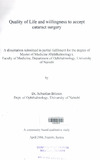| dc.contributor.author | Briesen, Sebastian | |
| dc.date.accessioned | 2013-05-23T09:51:36Z | |
| dc.date.available | 2013-05-23T09:51:36Z | |
| dc.date.issued | 2008 | |
| dc.identifier.citation | Master of Medicine (Ophthalmology), | en |
| dc.identifier.uri | http://erepository.uonbi.ac.ke:8080/xmlui/handle/11295/24789 | |
| dc.description.abstract | Background: Cataract is the major cause of blindness worldwide. Programmes like Vision 2020
make a great effort to eliminate avoidable blindness; but still acceptance and uptake of cataract
surgical services remain low in developing countries. The barriers and factors that lead to refusal
of cataract surgery are of great interest in contemporary applied research activities. There is
growing recognition that measurement of a person's ability to perform daily activities which
require vision is more meaningful than measurement of his distance visual acuity. Vision-related
Quality of Life (VRQoL) Scales are a sensitive and useful tool to determine a patient's
impairment in his daily life. So far little is known about the correlation between subjective
perception of the visual impairment and the decision making processes towards cataract surgery.
Aim: The aim of the study was to determine whether the vision related Quality of Life scores
differ among people who accept and those who refuse cataract surgery. Further objectives were
to determine the socioeconomic variables influencing QoL scores and the decision to accept
cataract surgery.
Methods: 144 people with visual impairment due to •c• ataract were interviewed during outreach
activities at Kwale District. 33 of them refused and III accepted free cataract surgery. The
WHO Quality of Life questionnaire WHO/PBD VFQ-20 was used to determine the vision
related Quality of Life; the socioeconomic variables were collected using structured
questionnaires.
Results: There was a strong correlation between Visual Acuity and vision related QoL-scores,
as expected. The second variable independently influencing QoL score was Literacy
(Education). People with 10)Ver educational level had poorer QoL scores. Other
sociodemographic factors like gender or marital status did not independently influence QoL
scores. People with poor visual acuity were not more likely to accept surgery than people with
better vision. The strongest predictor of acceptance was the QoL score. For every point decrease
in QoL there was a 1.08 fold higher chance that surgery was accepted. The other factor that
influenced acceptance independently was the gender. Males were 4,4 times more likely to accept
than females.
Conclusion: Visual acuity was not a predictor of someone's decision whether to accept or
refuse free cataract surgery. The factors independently influencing acceptance were the QoL
scores and being male. QoL scales are a useful tool to find out about someone's affection due to
visual impairment and his potential willingness to accept free surgery. | en |
| dc.description.sponsorship | University of Nairobi | en |
| dc.language.iso | en | en |
| dc.title | Quality of Life and willingness to accept cataract surgery | en |
| dc.type | Thesis | en |
| dc.description.department | a
Department of Psychiatry, University of Nairobi, ; bDepartment of Mental Health, School of Medicine,
Moi University, Eldoret, Kenya | |
| local.publisher | Faculty of Medicine, Department of Ophthalmology, University of Nairobi | en |

